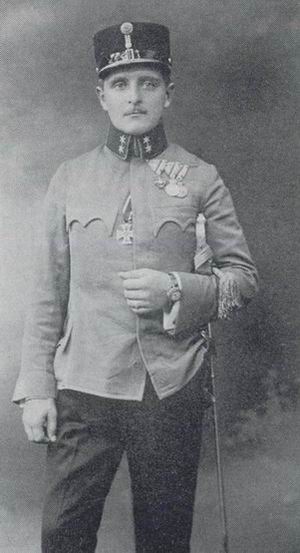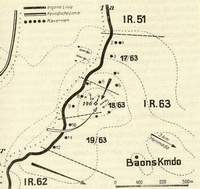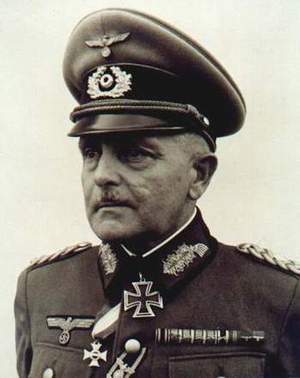Friedrich Franek
 Generalleutnant Friedrich Franek was born on the 16th of July 1891 in Vienna, the son of a master baker. After attending a junior high school he entered the Infantry cadet school at Liebenau near Graz. He graduated from there on the 18th August 1910 as a Fähnrich (Senior Officer
Cadet) and was assigned to Infanterie-Regiment 41 then garrisoned at Czernowitz in the Bukowina. Commissioned on the 1st of May 1913 he was posted as a platoon commander to IR.63 at Bestercze in the Siebenbürgen. He participated in the battle of Lemberg on the 8th of September 1914 and was wounded in the mouth, neck and chest during an assault East of
Grodek. Promoted to Oberleutnant on 1st March 1915 he returned to duty as a company commander in April.
He was again lightly wounded on the 15th of June during an assault on Krakowiec when a shot grazed his head. Returning to duty for the third time in October 1915, Franek assumed another company command appointment during the defensive fighting on the River Serwetsch East of Baranowitshi but was stricken with Typhus in early February 1916. He returned to the front for the fourth and last time in the middle of June 1916. He variously held company command and the appointment of regimental adjutant of IR.63 in this period.
Generalleutnant Friedrich Franek was born on the 16th of July 1891 in Vienna, the son of a master baker. After attending a junior high school he entered the Infantry cadet school at Liebenau near Graz. He graduated from there on the 18th August 1910 as a Fähnrich (Senior Officer
Cadet) and was assigned to Infanterie-Regiment 41 then garrisoned at Czernowitz in the Bukowina. Commissioned on the 1st of May 1913 he was posted as a platoon commander to IR.63 at Bestercze in the Siebenbürgen. He participated in the battle of Lemberg on the 8th of September 1914 and was wounded in the mouth, neck and chest during an assault East of
Grodek. Promoted to Oberleutnant on 1st March 1915 he returned to duty as a company commander in April.
He was again lightly wounded on the 15th of June during an assault on Krakowiec when a shot grazed his head. Returning to duty for the third time in October 1915, Franek assumed another company command appointment during the defensive fighting on the River Serwetsch East of Baranowitshi but was stricken with Typhus in early February 1916. He returned to the front for the fourth and last time in the middle of June 1916. He variously held company command and the appointment of regimental adjutant of IR.63 in this period.
In June 1917 the regiment moved to the Southwest front as part of the 35.Infanterie-Division and participated in the 10th and 11th battles of the
Isonzo. 35.Infanterie-Division, then commanded by Feldmarschalleutnant Eugen von
Podhoránszky was subordinated to Feldmarschalleutnant Maximilian von
Csicseric's XXIII. Korps. XXIII. Korps was in turn subordinated to Abschnitt III
or the Sector Command of General der Infanterie Johann Ritter von Henriquez with
responsibility for the Southernmost sector of the Isonzo Front. Facing
35.Infanterie-Division on this sector were the men of the Italian XIII Corps of
the Duke of Aosta's 3rd Army.
 Franek as the company commander of 17./IR.63 held the North slope of the especially important and exposed hill
146 which was itself situated approximately 500 metres to the Northeast of the
village of Flondar about five kilometres East of Monfalcone. The regiment held a
line of fortified caverns in the forward line. On the 17th and 18th of August 1917 with the commencement of the 11th battle, the position came under heavy Italian drum fire. The Italian infantry attacked on the 19th of August and by early morning had succeeded in breaking into various parts of the Austrian position. Franek's company mounted a surprise counter-attack
and caught the enemy unawares from the rear retaking two captured caverns.
At the same time the neighbouring 18./IR.63 to the left (South) had been pushed
back so the left flank of Franek's company was placed in considerable danger. By a further energetic and decisive attack the enemy was thrown back off the Austrian positions and the situation was restored.
Similar attacks were mounted with increasing ferocity over the following days.
Early on the morning of the 20th August the enemy attacked the position to the
South while simultaneously suppressing the defending company with heavy
artillery fire. When after a hard struggle the heavily weakened company holding
the sector to the left had been overwhelmed and partly wiped out, the enemy then
stormed from the South against the now open flank of the 17th Company. At this
critical juncture, Franek decided to mount a counter-attack with his company
reserve and succeeded in throwing back the Italians, retaking the just lost
position to the South. The 30 strong counter-attack force followed up their
success pursuing the now retreating Italians and took captive the occupants of
two cavern positions recently lost to the enemy. However Franeks' weakened
company was now compelled to give up their exposed position on hill 146 as the
neighbouring companies on either flank had withdrawn. The battle for the hill
see-sawed with it being retaken again on the morning of the 21st, lost again
that evening at 2145 hours in bitter hand to hand fighting only to be retaken
yet again by Franek's 17./IR.63. The Italians attacked for the sixth time at
1400 hours on the 22nd August and indeed this was the most difficult day since
the commencement of the battle on the 17th. Like all the previous attacks the
flanks of Franek's position were lost, yet surrounded on three sides 17th
Company held its positions. The seventh and last enemy attack was also held on
the 23rd of August. IR.63 was at last relieved on hill 146 at 0500 hours on the morning of the 24th August.
Franek as the company commander of 17./IR.63 held the North slope of the especially important and exposed hill
146 which was itself situated approximately 500 metres to the Northeast of the
village of Flondar about five kilometres East of Monfalcone. The regiment held a
line of fortified caverns in the forward line. On the 17th and 18th of August 1917 with the commencement of the 11th battle, the position came under heavy Italian drum fire. The Italian infantry attacked on the 19th of August and by early morning had succeeded in breaking into various parts of the Austrian position. Franek's company mounted a surprise counter-attack
and caught the enemy unawares from the rear retaking two captured caverns.
At the same time the neighbouring 18./IR.63 to the left (South) had been pushed
back so the left flank of Franek's company was placed in considerable danger. By a further energetic and decisive attack the enemy was thrown back off the Austrian positions and the situation was restored.
Similar attacks were mounted with increasing ferocity over the following days.
Early on the morning of the 20th August the enemy attacked the position to the
South while simultaneously suppressing the defending company with heavy
artillery fire. When after a hard struggle the heavily weakened company holding
the sector to the left had been overwhelmed and partly wiped out, the enemy then
stormed from the South against the now open flank of the 17th Company. At this
critical juncture, Franek decided to mount a counter-attack with his company
reserve and succeeded in throwing back the Italians, retaking the just lost
position to the South. The 30 strong counter-attack force followed up their
success pursuing the now retreating Italians and took captive the occupants of
two cavern positions recently lost to the enemy. However Franeks' weakened
company was now compelled to give up their exposed position on hill 146 as the
neighbouring companies on either flank had withdrawn. The battle for the hill
see-sawed with it being retaken again on the morning of the 21st, lost again
that evening at 2145 hours in bitter hand to hand fighting only to be retaken
yet again by Franek's 17./IR.63. The Italians attacked for the sixth time at
1400 hours on the 22nd August and indeed this was the most difficult day since
the commencement of the battle on the 17th. Like all the previous attacks the
flanks of Franek's position were lost, yet surrounded on three sides 17th
Company held its positions. The seventh and last enemy attack was also held on
the 23rd of August. IR.63 was at last relieved on hill 146 at 0500 hours on the morning of the 24th August.
 Franek assumed command of the divisional assault company later
expanded to battalion strength in the middle of September 1917. He had additionally by then been awarded the Golden Bravery Medal for officers. In April of the following year he was assigned to a general staff officer aspirant course held in Belgrade and in June returned to the 35.ID. as a staff officer. He was posted to the staff of 62.ID. in October and promoted to captain a few days before the wars end on the 1st of November 1918.
Franek assumed command of the divisional assault company later
expanded to battalion strength in the middle of September 1917. He had additionally by then been awarded the Golden Bravery Medal for officers. In April of the following year he was assigned to a general staff officer aspirant course held in Belgrade and in June returned to the 35.ID. as a staff officer. He was posted to the staff of 62.ID. in October and promoted to captain a few days before the wars end on the 1st of November 1918.
Franek remained in the Austrian Bundesheer after the war and for his own personal gallantry and that of his company during the battles at hill 146 was awarded the Knights' Cross of the Order of Maria Theresa in the 187th awards ceremony on 10th June 1921.
Between 1919 and 1929 he served as a company commander, battalion adjutant and
instructor at military schools. He qualified as a Doctor of political science on the
20th of
May 1924 and was promoted to Major on the 27th of September 1927. From the
Spring of 1925 he had attended General Staff training and on the 1st of October
1929 he was seconded to the War Archives in Vienna. Whilst at the War Archives
he participated in authoring the multi-volume official Austrian history of the
First World War. From 1st October 1934 until the 1st November 1938 he was a tactics instructor at the Maria Theresa Military Academy at
Wiener-Neustadt having been promoted to Obserstleutnant on the 15th of November
1934. Following the annexation of Austria by Germany he was transferred into the Wehrmacht in his then present rank as a battalion commander in IR.32
at Teplitz-Schönau and progressed through regimental and divisional command. He was awarded the Knights' Cross of the Iron Cross on 4th November 1941 for bravery whilst commanding
IR.405. Probably his most
notable command was a four month stint leading the famous Austrian 44.ID. "Hoch und Deutschmeister in the Spring
of 1944 at Monte Cassino. Captured by the Russians whilst commanding
73.ID. General Franek remained a prisoner of war until 22nd July 1948. The General died in Vienna on the 8th April 1976.
Of note is the fact that General Franek and General Alois Windisch were the only two
officers of the former Austro-Hungarian army to be awarded both the Knights'
Cross of the Order of Maria Theresa and the Knights' Cross of the Iron Cross.
Uniquely General Franek was the only individual to win both the above mentioned
awards and the Golden Bravery Medal for Officers.
Back to Miscellaneous Biographies

Copyright ©
Glenn Jewison 01 Mar 2001
 Generalleutnant Friedrich Franek was born on the 16th of July 1891 in Vienna, the son of a master baker. After attending a junior high school he entered the Infantry cadet school at Liebenau near Graz. He graduated from there on the 18th August 1910 as a Fähnrich (Senior Officer
Cadet) and was assigned to Infanterie-Regiment 41 then garrisoned at Czernowitz in the Bukowina. Commissioned on the 1st of May 1913 he was posted as a platoon commander to IR.63 at Bestercze in the Siebenbürgen. He participated in the battle of Lemberg on the 8th of September 1914 and was wounded in the mouth, neck and chest during an assault East of
Grodek. Promoted to Oberleutnant on 1st March 1915 he returned to duty as a company commander in April.
He was again lightly wounded on the 15th of June during an assault on Krakowiec when a shot grazed his head. Returning to duty for the third time in October 1915, Franek assumed another company command appointment during the defensive fighting on the River Serwetsch East of Baranowitshi but was stricken with Typhus in early February 1916. He returned to the front for the fourth and last time in the middle of June 1916. He variously held company command and the appointment of regimental adjutant of IR.63 in this period.
Generalleutnant Friedrich Franek was born on the 16th of July 1891 in Vienna, the son of a master baker. After attending a junior high school he entered the Infantry cadet school at Liebenau near Graz. He graduated from there on the 18th August 1910 as a Fähnrich (Senior Officer
Cadet) and was assigned to Infanterie-Regiment 41 then garrisoned at Czernowitz in the Bukowina. Commissioned on the 1st of May 1913 he was posted as a platoon commander to IR.63 at Bestercze in the Siebenbürgen. He participated in the battle of Lemberg on the 8th of September 1914 and was wounded in the mouth, neck and chest during an assault East of
Grodek. Promoted to Oberleutnant on 1st March 1915 he returned to duty as a company commander in April.
He was again lightly wounded on the 15th of June during an assault on Krakowiec when a shot grazed his head. Returning to duty for the third time in October 1915, Franek assumed another company command appointment during the defensive fighting on the River Serwetsch East of Baranowitshi but was stricken with Typhus in early February 1916. He returned to the front for the fourth and last time in the middle of June 1916. He variously held company command and the appointment of regimental adjutant of IR.63 in this period. 